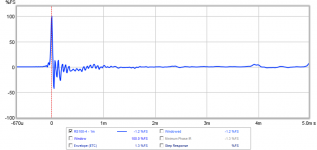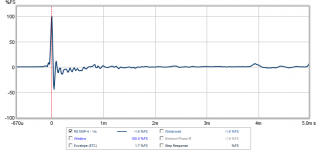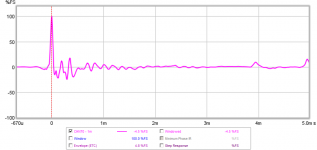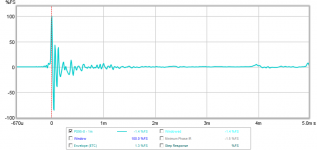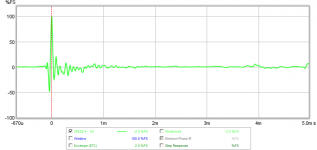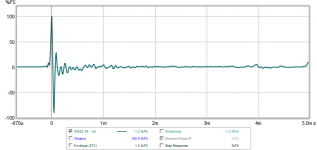Thanks for all the hard work, X. I cannot say enough about how valuable these measurements are.
It looks like there is an early reflection from the room in these measurements. See the peaks/dips below 1000 Hz. You should be able to see it quite clearly in the impulse response. That reflection must be gated out. It might increase your gate to 300 Hz or more, and reduce the resolution (gating frequency = frequency resolution). The graphs would look smoother without the reflection.
It looks like there is an early reflection from the room in these measurements. See the peaks/dips below 1000 Hz. You should be able to see it quite clearly in the impulse response. That reflection must be gated out. It might increase your gate to 300 Hz or more, and reduce the resolution (gating frequency = frequency resolution). The graphs would look smoother without the reflection.
Thanks for providing measurements!
The Vifa and Daytons look good to me. The Daytons are especially attractive given the price and ability to match with larger variants in the Reference line for building a FAST setup.
xrk, do you have any issues with imaging/stage with a single bass unit? I see it yields a great frequency response, but bass above 80hz is not omnidirectional and I would think the crossover at ~200-250hz would have an effect on the sound.
The bass unit sits below the full range top. The centerline of the exit aperture of the sub is 11 in from the centerline of the top. I think that is close enough to be integrated and directionally consistent with full range driver.
Thanks for all the hard work, X. I cannot say enough about how valuable these measurements are.
It looks like there is an early reflection from the room in these measurements. See the peaks/dips below 1000 Hz. You should be able to see it quite clearly in the impulse response. That reflection must be gated out. It might increase your gate to 300 Hz or more, and reduce the resolution (gating frequency = frequency resolution). The graphs would look smoother without the reflection.
Here are the IR's.
TC9FD
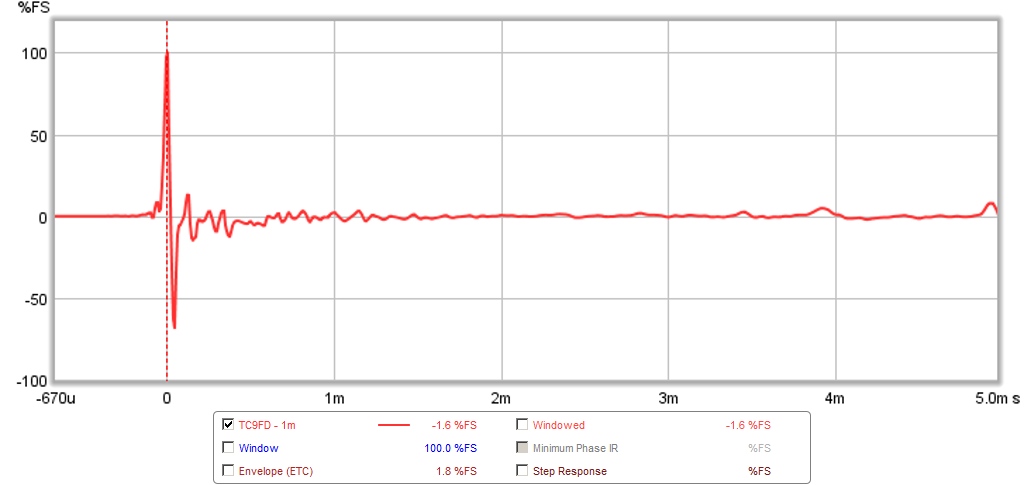
3FE22-4
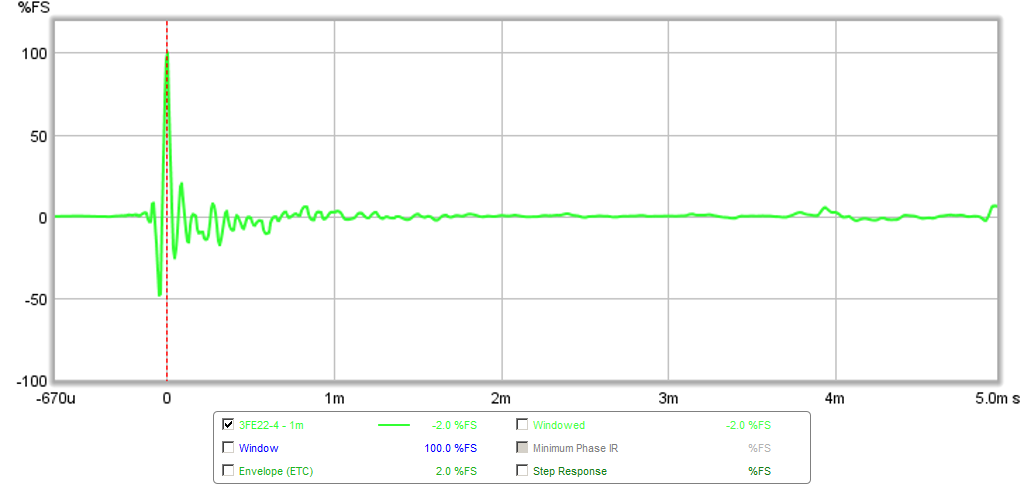
3FE22-16
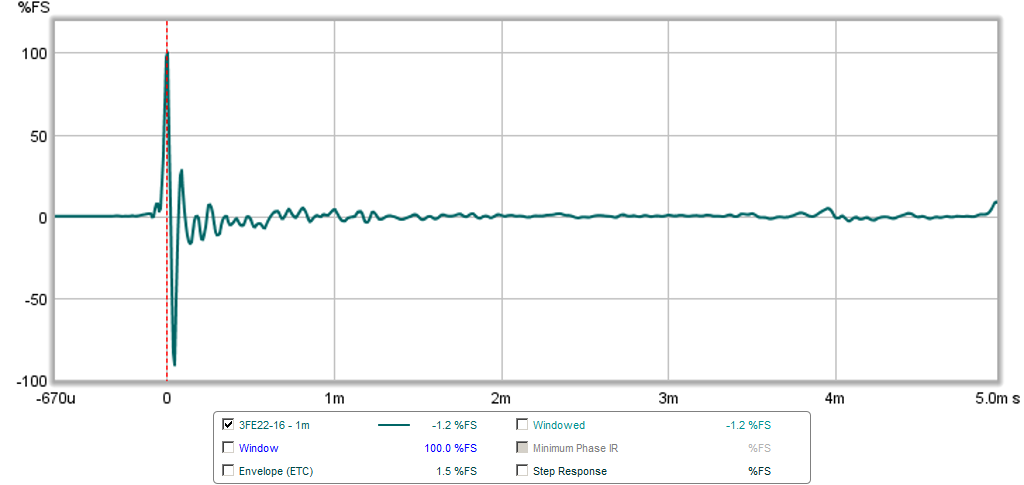
RS100-4
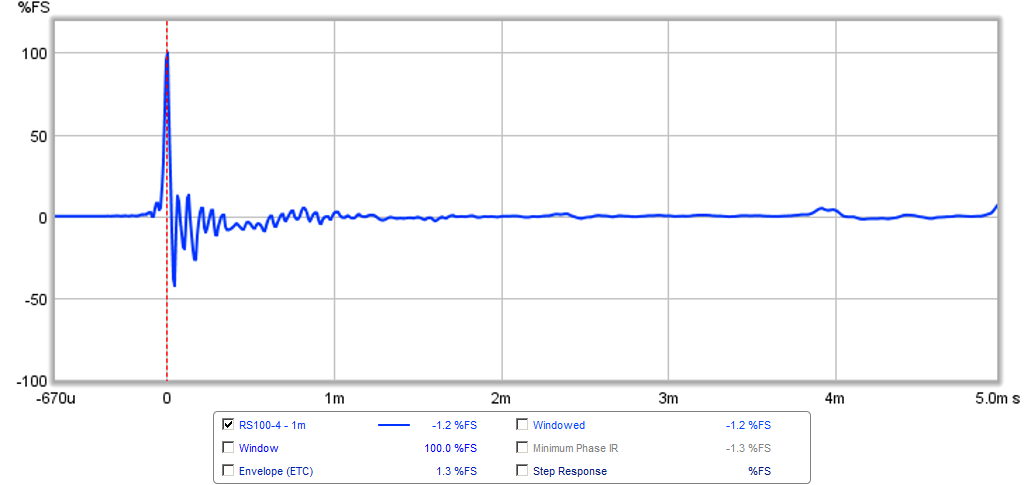
RS100P-4
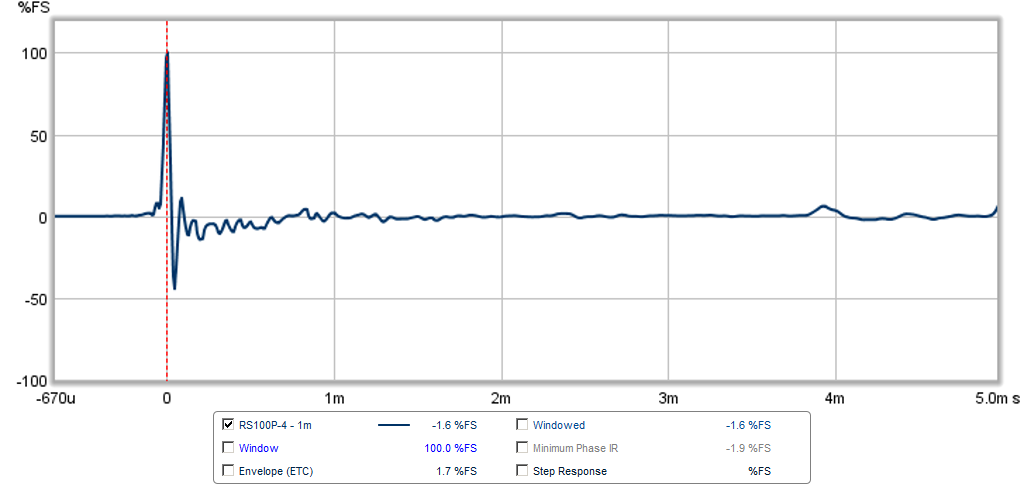
I see what you are saying, there is a very small reflection at 3.9 ms. That is 48 in - not sure what that corresponds to because the reflection of the floor to the mic is measured to be 96in.
CHN-70
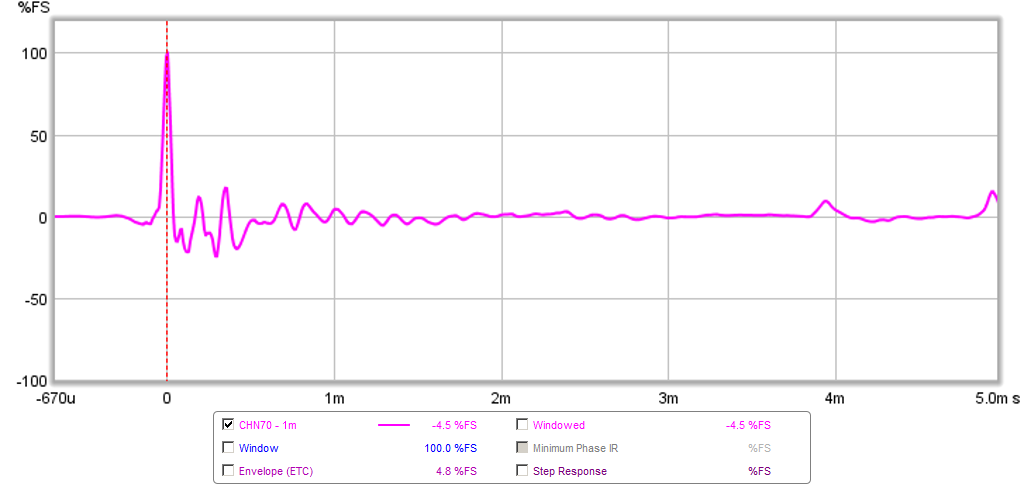
PS95-8
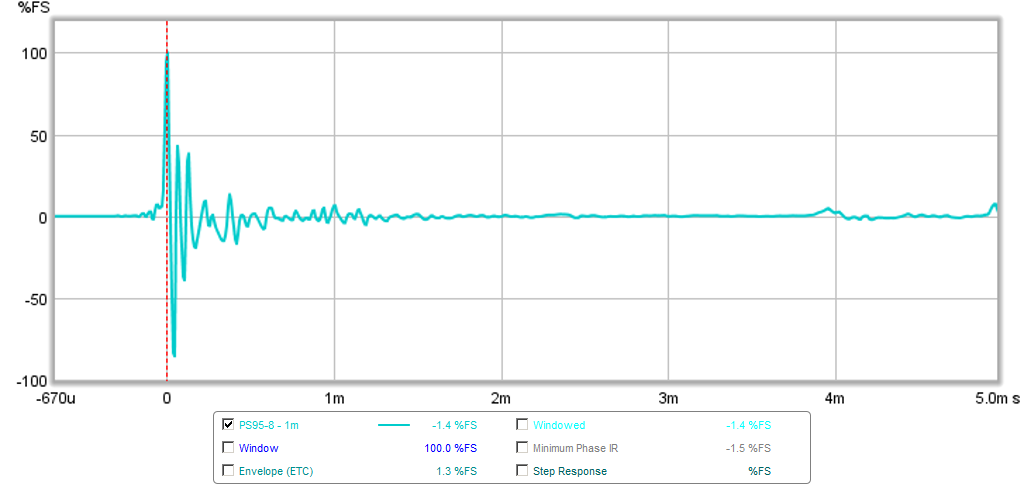
Attachments
Last edited:
.... this should prove it's possible to measure in a home environment, and another good argument is that it's factual in home environment we listen to speakers so had there bean difference we couldn't care less because we don't have anechoic chambers the house.
This is not entirely true. While reflections mess up our home measurements, our ear/brain does not process the sound like the measurement. Direct sound is heavily weighted, early reflections color the sound and late reflections are ignored. Perception is also frequency dependent. Late reflections don't affect the perceived HF much.
What does this mean for measuring in our homes? We need to gate the reflections out. All common measurement software allows you to do that (REW, HolmImpulse, ARTA, etc). Gating the reflections out allows you to see the direct sound coming from the speaker. The ear/brain is extremely good at separating the sound of the speaker from the sound of the room. You can be in a big auditorium or a small bedroom, you can still recognize the voice of your wife.
Once you gate out the reflections, you will see measurements similar to those that XRK just posted. LF information should be ignored, and the resolution in the HF is where the gate is at. If you are gating 300 Hz, only data above 300 Hz is valid and your resolution is 300 Hz. This is the main difference from an anechoic chamber or measuring outside. If there is no reflection, like in an anechoic chamber then the resolution can be as high as 2 Hz. But we do not need this resolution in the high frequencies because our ear/brain hears frequency bins in the HF, so a 300 Hz resolution is "good enough."
But it is important to gate out the reflections. Otherwise you see the comb-filtered peaks and dips, which is definitely not what we hear. The gated measurement is good for the HF, and then you can combine it with a near field measurement, where you place the mic very close to the speaker, near the dustcap. You stitch the two measurements together and it is called a quasi-anechoic measurement.
For full range drivers, we are mainly interested in 300 Hz and above. Lower than that the room dominates anyway. This means that below about 300 Hz, what you measure, reflections included, is what you hear. This is why the low frequencies sound different in different rooms even with the same speaker.
When you want to EQ, you want to EQ the measurement with reflections included up to about 300 Hz. And you want to EQ 300 Hz up using the reflection-free measurement.
Last edited:
I see what you are saying, there is a very small reflection at 3.9 ms. That is 48 in - not sure what that corresponds to because the reflection of the floor to the mic is measured to be 96in.
Yup, there's one at 3.9 ms and one just before 5 ms. I calculated 4 feet from the peak/dip cycle also.
The reflection could be baffle related also. For example, if your baffle edge is 2 feet away from the center of the driver, you will see the reflection at 4'. You could try gating out the 3.9 ms reflection and see what you get. Also, 1/24th might be enough resolution. I know I asked for 1/48th but I had the full IEC baffle in mind.
Thanks again for your hard work!
Bummer about the dips in the CHN-70s. Ordered a pair and I'll try to get some corroborating measurements in the near future.
I agree with ra7, it looks like you need a 3ms gate. Typical of the home environment. Measure at 0.5 or 0.75m and you could probably get away with 4 or 4.5ms. This is why going outside is really helpful. At 3ms you data won't be very good below about 1000hz and will be useless below about 400hz. You could add a bat of insulation on the floor and ceiling to try and slow down the reflection but it'll only get you maybe 1/2ms. Maybe.
EDIT - The reason I suggest 3ms and not 3.9 is because you need to allow for some of the taper in the gating. It's not a brick wall. You can do about 3.5ms and let a little bit of the reflection "sneak past" but for the cleanest picture up high I'd go with 3ms.
EDIT - The reason I suggest 3ms and not 3.9 is because you need to allow for some of the taper in the gating. It's not a brick wall. You can do about 3.5ms and let a little bit of the reflection "sneak past" but for the cleanest picture up high I'd go with 3ms.
I might repeat the measurements at 0.5m, put some soft damping on the floor, use 4ms gate, drop drive voltage by 6dB should get the same absolute SPL.
Bummer about the dips in the CHN-70s. Ordered a pair and I'll try to get some corroborating measurements in the near future.
Don't have regrets until you listen to them.
Still early, but after 200 more hrs of breakin i pulled the little VIFA up for a visitor to listen to, and the CHN still cleans their clock. The differences are in the detail, the low level bits that give body to music, voice and the image/soundstage, something none of the measures explore. The Vifas are headed back for more break-in.
dave
You are right Dave. When I tried a different amp on 8" silver flute plus jbl 2407h on a round mcm horn, I was amazed that running just the woofer (up to 2khz and 6db down there), there was much better texture on voice. Definitely something I expected to hear on the tweet, not the woofer.
So you are onto DDR, micro resolution maybe ?
Norman
So you are onto DDR, micro resolution maybe ?
Norman
Don't have regrets until you listen to them.
Still early, but after 200 more hrs of breakin i pulled the little VIFA up for a visitor to listen to, and the CHN still cleans their clock. The differences are in the detail, the low level bits that give body to music, voice and the image/soundstage, something none of the measures explore. The Vifas are headed back for more break-in.
dave
When listening thru my guitar amp AC30 or just use its guitar drivers as reproducing speaker i too get higher detail low level bits, body to music and voice, but it's very track and genre dependent and probably very colored against what producer heard when mixed final cut 🙂.
Bummer about the dips in the CHN-70s. Ordered a pair and I'll try to get some corroborating measurements in the near future.
Don't know if you listened to the sound clips of the CHN70's in the FAST I posted earlier. I can't stand the elevated plateau from 600Hz to 5kHz - without EQ to flatten that it sounds harsh and shouty. Unlistenable without treatment IMO.
A driver with coloration in the FR from peaks and dips is perhaps adding low level detail via an acoustic "after taste" (from extended temporal presence due to ringing) - it was never there in the levels meant to be heard in the recording.
I would be very interested to get another opinion on how they sound and corroboration on how they measure.
Last edited:
Don't have regrets until you listen to them.
Still early, but after 200 more hrs of breakin i pulled the little VIFA up for a visitor to listen to, and the CHN still cleans their clock. The differences are in the detail, the low level bits that give body to music, voice and the image/soundstage, something none of the measures explore. The Vifas are headed back for more break-in.
dave
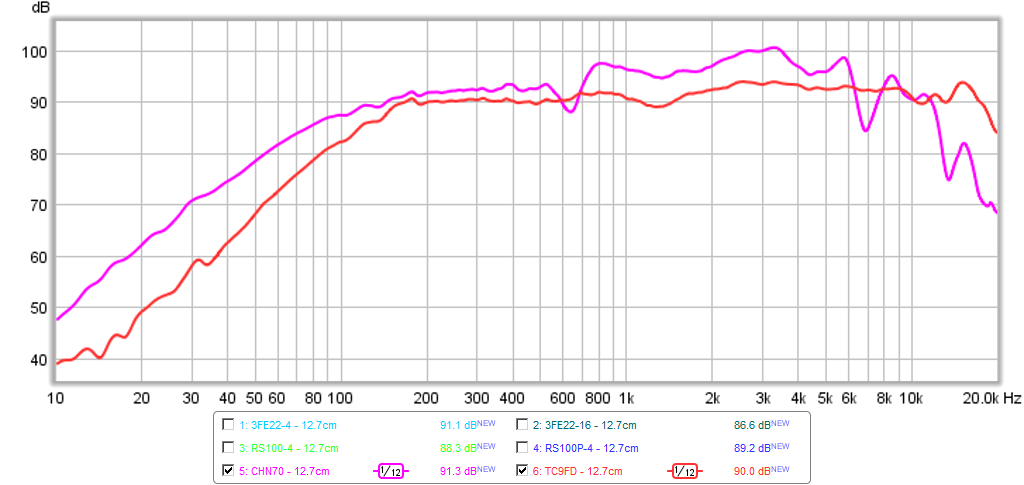
If you think that the sound from a speaker playing with a response as ragged as the above magenta curve cleans the clock of the smoother red curve, you are probably the only one who would think so.
Last edited:
ra7,
Great thanks taking time give us tips in a not too complicated way of speaking (slow tempo).
The stuff about we definitely not hear comb-filtered peaks and dips as the microphone i have difficult to understand if ear is placed as same spot as microphone, or i mix up or misunderstand stuff.
Look forward the plot results we end up with compared plots at #1 when xrk971 got tweaked testing setup as requested, it's very educating.
Great thanks taking time give us tips in a not too complicated way of speaking (slow tempo).
The stuff about we definitely not hear comb-filtered peaks and dips as the microphone i have difficult to understand if ear is placed as same spot as microphone, or i mix up or misunderstand stuff.
Look forward the plot results we end up with compared plots at #1 when xrk971 got tweaked testing setup as requested, it's very educating.
Last edited:
The differences are in the detail, the low level bits that give body to music, voice and the image/soundstage, something none of the measures explore. The Vifas are headed back for more break-in.
This is 100% not true. The measurements explore exactly the things you are talking about: detail, low-level information, body, image, soundstage. All this information is in the measurements that XRK is showing. I linked to this interactive chart in the Vifa thread:
Interactive Frequency Chart - Independent Recording Network
The recording folks, you know the guys who put the music together for you to listen to, know this information. It behooves us, as speaker designers, to know about it also.
At the top of the chart in the link above are the male and female vocals and their frequencies. If you hover your pointer over the female vocal, in the "Instrument Data" box you will see this in the :
Fullness: 240 Hz
Presence/recognition: 2-4 kHz
Sibilance: 4-9 kHz
Breath/Air: >10 kHz
What this means is that if you have a peak in the 4-9 kHz, you will likely hear it as sibilance. Sibilance is an emphasis on the "ssss" sound. Easily heard. If there are peaks in 2-4 kHz, you will hear more detail because the recognition of words is improved, but that detail is not there in the original recording. What's worse is your driver is coloring carefully engineered recordings. It is fun at first, but fatiguing after some time. When you hear a flat-measuring driver like the Vifa TC9, you can immediately hear the difference. It will sound smooth, non-fatiguing on a lot of different types of music. Some might call it "boring" at first compared to the CHN70, but sit and listen to it for a while and it's superiority will be obvious.
If you hover over the 100 Hz range, in the "Spectrum Data" box, it will say:
"Increase to make sound fatter," "Decrease to make sound thinner." What the recording/mastering engineer is doing is increasing or reducing frequency response in this area to give it the right sound. Your description of "body" is somewhere in there. Now, X's measurements will not show this because the frequency range below 200 Hz is very room dependent and to get the right "body" you will need to EQ the sound in the LF.
The conclusion here is that we need to educate ourselves about why the frequency response measurements are important. They completely define what we hear.
Last edited:
So you are onto DDR, micro resolution maybe ?
Good DDR is an absolute requirement for good-to-excellent information expression that gives texture & nuance to voice & insturment and vital for a good 3D image/soundstage.
These are necessary so that your brain doesn't have to try to fill in what is missing, so it is working less and you can relax more and enjoy/connect with the music.
dave
If you think that the sound from a speaker playing with a response as ragged as the above magenta curve cleans the clock of the smoother red curve, you are probably the only one who would think so.
The CHN is decidely better than the Vifa despite what your graph says (and given some of the latest comments about measuring distance and proper gating, not very accurate measures). If you are measuring before you listen you may well be adding expectation bias to your listening session -- i have seen a lot of that.
dave
The measurements explore exactly the things you are talking about: detail, low-level information, body, image, soundstage.
They do not. Low-level information is MIA with the VIFA. A lot better with the CHN, and even better with the A10PeN in FHXL we slid in at the end of the session.
These measures only scratch the surface of what is happening. They are an interesting excersize, but unable to quantify the performance of a loudspeaker.
I will keep giving the little VIFAs more break-in and get more people to listen to them, but so far they are at the losing end of a 3-nil score.
dave
FR does not totally characterize a driver. You're missing:
Polar response
Bass response
CSD
HD
Impedance
Compression
And more
Nevertheless this data is still great.
Polar response
Bass response
CSD
HD
Impedance
Compression
And more
Nevertheless this data is still great.
Lol, how do we measure resolution ?
Or transparency, such an an electrostatic speaker ?
I think it is a factor depending on what the listener believes is priority. Some like flat response, others low distortion, some phase sensitive, or others simply not caring about some of these details.
Norman
Or transparency, such an an electrostatic speaker ?
I think it is a factor depending on what the listener believes is priority. Some like flat response, others low distortion, some phase sensitive, or others simply not caring about some of these details.
Norman
- Status
- Not open for further replies.
- Home
- Loudspeakers
- Full Range
- An Objective Comparison of 3in - 4in Class Full Range Drivers
